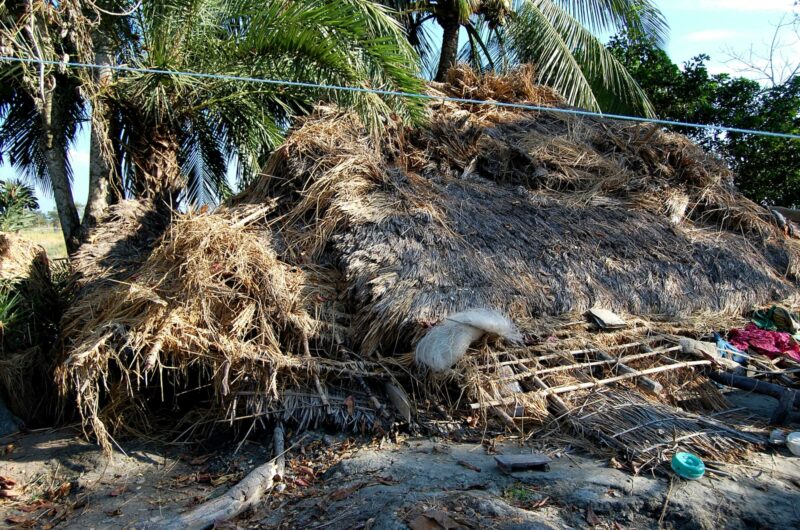“It’s complicated” – loss and damage in the IPCC Sixth Assessment Report
The draft outline of the IPCC Sixth Assessment Report doesn’t contain an explicit reference to loss and damage but will deal with “residual risks”, “adaptation limits” and “attribution.” Should this outline be adopted at the next IPCC plenary, it would be a missed opportunity to bring the entire spectrum of loss and damage available in the scientific literature into focus and support vulnerable countries in preparing do deal with it.
Share

Vulnerable country scientists came to the IPCC scoping meeting in in early May in Addis Ababa prepared to help ensure that the outline of the Sixth Assessment Report (AR6) adequately reflected available scientific information most vital to planning and decision-making in their regions. Loss and damage is one of their key concerns.
This scoping meeting brought together nominated experts from across the relevant disciplines and government IPCC focal points to produce a draft outline of AR6. The IPCC panel will approve the outline in early September. Reports of the three AR6 Working Groups will be finalised in 2021, followed by a Synthesis Report in 2022.
The outline does not set things in stone and authors will mostly be guided by the available literature but it is important as it guides the choice of lead authors. The outline can also serve as a communication tool, signalling to the research community what emerging and relevant knowledge is needed for decision making in the context of climate change.
Great progress but missed opportunities
The inclusion of residual risks and adaptation limits in the AR6 shows progress towards providing science-based information for decision-making. It will certainly enhance the relevant knowledge base and support those working on loss and damage.
And yet, more could have been achieved. Reference to loss and damage could have signalled to the research community that knowledge is needed on the issue, triggering scientific contributions necessary to clarify the concept of loss and damage and develop adequate solutions.
Loss and damage will not go away. Emissions reductions to date have been far too low to keep all climate change impacts at bay. There is good reason to take these risks and impacts into focus, prepare for them and support those least able to prepare themselves.
What is loss and damage?
“Loss and damage” chronically suffers from a lack of definition. Typically, those affected refer to it as impacts that have already occurred and the adverse effects of climate change that can no longer be avoided through adaptation or mitigation. Others insist on references to risk reduction and aversion, i.e. means of avoiding the seemingly unavoidable.
The Loss and Damage in Vulnerable Countries Initiative, which presented nine vulnerable country case studies defined it as “the negative effects of extreme weather events and slow-onset climatic changes that people have not been able to cope with or adapt to” (Warner & van der Geest 2013).
While some of the background behind the lack of definition may indeed be politically motivated – to some, the notion of unavoided impacts has a whiff of compensation about it – much of it is not.
Take the example of losses covered by insurance. Insurance only becomes effective after the event, i.e. an event associated with losses triggers payouts. But these payouts help avoid further losses, for example by allowing businesses to continue their daily work rather than invest all their resources into reconstruction. Insurance can also further contribute to the avoidance of impacts by stipulating risk-averting behavior. Does insurance thus fall under the category of adaptation or under the category of loss and damage? The empirical basis does not offer itself easily to conceptual clarity.
If the lack of definition and conceptual clarity is reason enough to call the issue political, the same argument could apply to adaptation. Adaptation is also a vague concept grouping highly diverse actions ranging from autonomous to nationally planned, and from anticipatory to reactive. It is notoriously hard to differentiate from development. Its vagueness has political consequences – for example, when projects are denied funding because they cannot sufficiently be told apart from development projects. And yet this has not led the IPCC to shy away from including adaptation in the scope of its work.
The compromise – limits to adaptation and residual risks
As in the outlines of the special reports on land and oceans, the compromise on loss and damage in the AR6 is the inclusion of concepts of “residual risks”, “adaptation limits” and “attribution.”
This will add much relevant knowledge to stakeholders working on loss and damage. It will likely also ensure that much of the relevant knowledge on loss and damage will be reflected. However, loss and damage is not the same as residual risks and limits to adaptation, and entails correspondingly different knowledge needs.
Limits to adaptation
“Limits to adaptation” describes the processes and factors that impede human action and planning. Loss and damage describes the type, scale and ideally timescales of challenges that necessitate human action beyond adaptation.
Preparing for loss and damage requires information on the timescales and magnitude of loss and damage already occurring and expected in the future, as well as on the type of loss and damage in order to know how best to address it.
Residual risks
Residual risk refers to the remaining risk of loss and damage that could occur even after adaptation and mitigation measures have been put in place. The literature on “residual risks” covers much of what is relevant for loss and damage and is pertinent to the planning and the choice of measures to address such risks. However, not all aspects related to loss and damage are covered under the umbrella of “risk.”
AR5 Working Group II glossary defines “risk” as “the potential for consequences where something of value is at stake and where the outcome is uncertain, recognising the diversity of values” (emphasis added). Uncertainty is thus a key component of the concept of risk.
Two categories of loss and damage would not qualify as residual risks: loss and damage that has already occurred and loss and damage due to slow-onset processes that are irreversible within the next decades and nearly certain to occur. Sea-level rise, for example, is set to continue due to past and ongoing greenhouse gas emissions, as is ocean acidification (see E.G. Siegele 2012). It is not clear whether in such cases of certain impacts, it is productive to speak of uncertain risks, and whether instruments tailored to deal with uncertain risks (e.g. insurance) will be adequate for dealing with such certain impacts.
At the very least, including residual impacts and a systematic discussion on ways to address them is key in covering the literature relevant to loss and damage.
The need for knowledge
The importance of loss and damage science was first officially recognised in 2013 by establishing the Warsaw International Mechanism for Loss and Damage Associated with Climate Change Impacts (WIM, for short).
The WIM Executive Committee has started its work in March 2014. The WIM´s goal, as agreed in decision 2/CP.19, is: (1) enhance the understanding of comprehensive risk management approaches to address loss and damage, (2) to strengthen dialogue, coordination, coherence and synergies among relevant stakeholders, and (3) to enhance action and support, including finance, technology and capacity-building to address loss and damage.
Given that members of the Executive Committee are not scientific experts on loss and damage, it is clear that in order to fulfil its first function, it relies on scientific inputs. Accordingly, it has opened its meetings to observers and has regularly requested and taken their inputs on board.
Reflecting the need for the integration of scientific expertise into the work of the body under the UNFCCC, COP22 decision 4/CP.22 asked the Executive Committee of the WIM to “ensure that the best available science is highlighted” in the WIM’s work. One would think the IPCC is the right body to synthesise and provide this science in a policy-relevant manner.
The growing body of literature
Loss and damage was mentioned only 30 times in the whole of IPCC WGII Fifth Assessment Report, and was not listed in the 30-page glossary (Van Der Geest & Warner, 2015).
The literature on loss and damage has grown significantly since then. A quick search under the keywords “loss and damage” and “climate” on peer-reviewed literature platform Scopus yields over 100 publications.
Some of this new literature assesses observed or projected loss and damage. Many authors are concerned with governance aspects, institutional settings and questions of justice.
All these issues are relevant and clearly merit attention. Why not systematically reflect them in reports that were conceived as comprehensive assessments of knowledge on climate change?
Further reading
Vulnerability, Coping and Loss and Damage from Climate Events, Kees van der Geest and Koko Warner (2015)
What the IPCC has to say about loss and damage. Kees van der Geest & Koko Warner (2015)
Loss and damage from climate change: local-level evidence from nine vulnerable countries, Koko Warner & Kees van der Geest (2013), Int. J. Global Warming Vol.5, No. 4 pp.367–386.
The theme of slow onset impact. Loss and Damage in Vulnerable Countries Initiative, Linda Siegele (2012)
See also:
What Does It Mean to “Address Displacement” Under the UNFCCC?: An Analysis of the Negotiations Process and the Role of Research, Olivia Serdeczny (2017)












